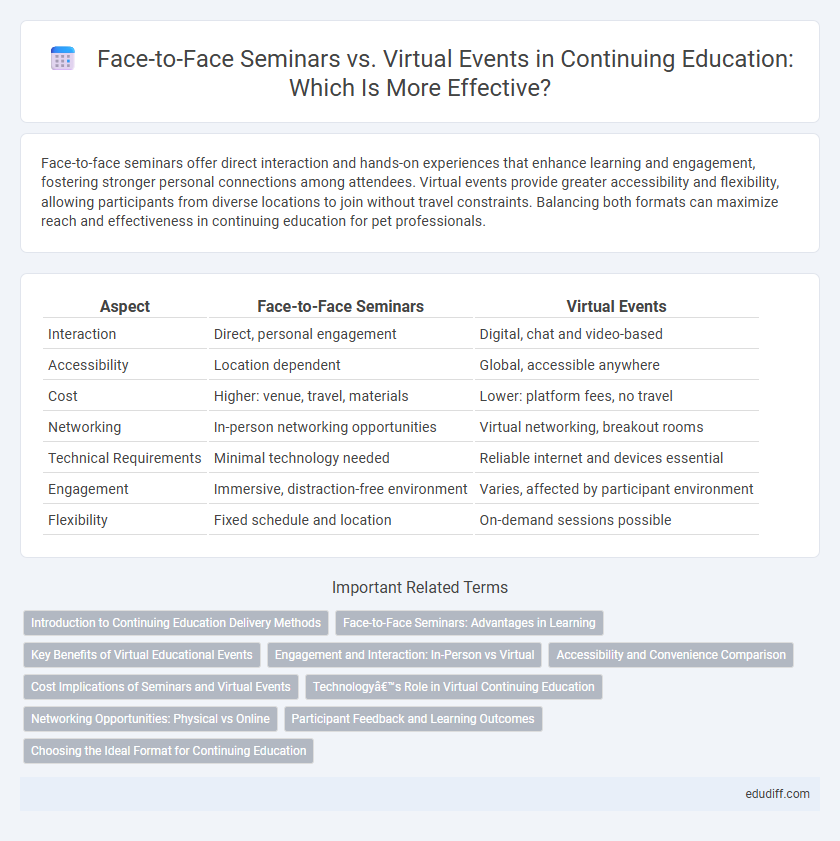Face-to-face seminars offer direct interaction and hands-on experiences that enhance learning and engagement, fostering stronger personal connections among attendees. Virtual events provide greater accessibility and flexibility, allowing participants from diverse locations to join without travel constraints. Balancing both formats can maximize reach and effectiveness in continuing education for pet professionals.
Table of Comparison
| Aspect | Face-to-Face Seminars | Virtual Events |
|---|---|---|
| Interaction | Direct, personal engagement | Digital, chat and video-based |
| Accessibility | Location dependent | Global, accessible anywhere |
| Cost | Higher: venue, travel, materials | Lower: platform fees, no travel |
| Networking | In-person networking opportunities | Virtual networking, breakout rooms |
| Technical Requirements | Minimal technology needed | Reliable internet and devices essential |
| Engagement | Immersive, distraction-free environment | Varies, affected by participant environment |
| Flexibility | Fixed schedule and location | On-demand sessions possible |
Introduction to Continuing Education Delivery Methods
Face-to-face seminars offer direct interaction, immediate feedback, and hands-on learning experiences crucial for skill-based continuing education. Virtual events provide flexible access, cost efficiency, and the ability to reach a global audience, enhancing scalability in continuing education delivery. Selecting the appropriate method depends on learner needs, content complexity, and objectives for effective knowledge retention.
Face-to-Face Seminars: Advantages in Learning
Face-to-face seminars enhance learning through direct interaction, allowing participants to ask questions and receive immediate feedback, which strengthens comprehension and retention. Physical presence fosters deeper engagement and collaboration, as non-verbal cues and group dynamics are more effectively communicated. Furthermore, these in-person events create a focused environment with fewer distractions, promoting better concentration and active participation.
Key Benefits of Virtual Educational Events
Virtual educational events offer unparalleled accessibility, enabling participants from diverse geographical locations to join without travel constraints. They provide cost-efficiency by eliminating expenses related to venue rentals, travel, and accommodation while allowing instant access to recorded sessions for flexible learning. Advanced interactive tools like live polls, Q&A, and breakout rooms enhance engagement and foster real-time collaboration among attendees.
Engagement and Interaction: In-Person vs Virtual
In-person seminars foster higher engagement through direct eye contact, spontaneous discussions, and non-verbal cues that enhance participant connection and attentiveness. Virtual events rely on chat functions, polls, and breakout rooms to simulate interaction but often face challenges like screen fatigue and technical issues limiting real-time responsiveness. Effective engagement in virtual settings requires deliberate facilitation and interactive technologies tailored to maintain participant focus and involvement.
Accessibility and Convenience Comparison
Face-to-face seminars often require participants to travel, incurring time and cost constraints that limit accessibility, especially for international attendees. Virtual events eliminate geographical barriers, enabling global participation from any location with internet access, which significantly increases convenience. The flexibility of virtual platforms allows on-demand access to recorded sessions, enhancing the overall accessibility and convenience compared to traditional in-person seminars.
Cost Implications of Seminars and Virtual Events
Face-to-face seminars often involve higher costs due to venue rental, travel, accommodation, and catering expenses, while virtual events significantly reduce these overheads by eliminating physical space and logistical needs. Technology investments for virtual platforms and potential technical support are primary costs but generally remain lower compared to in-person arrangements. Budget allocation reflects these differences, making virtual events a cost-efficient alternative for large-scale or frequent seminars.
Technology’s Role in Virtual Continuing Education
Technology drives virtual continuing education by enabling interactive platforms that simulate face-to-face seminars through video conferencing, real-time polls, and breakout rooms. Advanced learning management systems (LMS) facilitate personalized content delivery and track participant progress, enhancing engagement and knowledge retention. Virtual reality (VR) and augmented reality (AR) tools further immerse learners, offering hands-on experiences that replicate in-person training environments.
Networking Opportunities: Physical vs Online
Face-to-face seminars foster richer networking opportunities by enabling spontaneous interactions, nonverbal communication, and deeper personal connections that virtual events often lack. In-person settings facilitate trust-building and more meaningful conversations through shared physical experiences and immediate feedback. Conversely, virtual events expand reach and convenience but tend to limit organic networking due to technological barriers and reduced social cues.
Participant Feedback and Learning Outcomes
Participant feedback often highlights richer interaction and higher engagement levels in face-to-face seminars, contributing to improved learning outcomes through direct social cues and real-time discussions. Virtual events offer flexibility and accessibility, yet some participants report challenges with distractions and reduced networking opportunities, which can impact overall knowledge retention. Combining both formats through hybrid models can optimize participant satisfaction and enhance learning effectiveness by leveraging the strengths of each approach.
Choosing the Ideal Format for Continuing Education
Selecting the ideal format for continuing education depends on factors such as learner engagement, accessibility, and cost-effectiveness. Face-to-face seminars offer direct interaction and hands-on experience, fostering deeper networking opportunities, while virtual events provide flexible scheduling and broader reach, making them suitable for diverse geographic audiences. Analyzing participant needs, technological infrastructure, and educational objectives is essential to optimize the learning experience in either format.
Face-to-face Seminars vs Virtual Events Infographic

 edudiff.com
edudiff.com